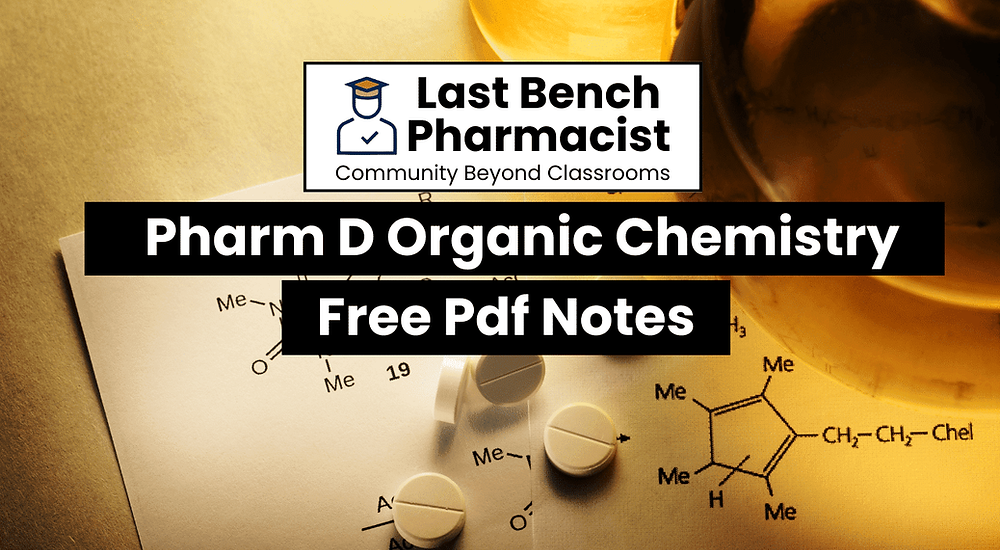



#pharmdnotes #pharmd1styearnotes #pharmdorganicchemistrynotes
Organic chemistry often gets a bad rap for being complex and intimidating. But fear not, pharmacy students! These Pharm D Organic chemistry PDF Notes equips you with a comprehensive set of Pharm D organic chemistry, designed to break down the subject into easy-to-understand concepts. We’ll explore key areas like functional groups, reactions, mechanisms, and their relevance to pharmaceutical applications. So, ditch the stress and dive into the world of organic chemistry with confidence, knowing these notes are your secret weapon for success!
Organic chemistry equips you to understand the building blocks of drugs (functional groups), how they’re made and broken down (reactions), and how their structure affects their effectiveness (structure-activity relationships). It’s the foundation for appreciating drug design and contributing to future advancements in pharmaceuticals.
a. IUPAC/Common system of nomenclature of simple organic compounds belonging to different classes of organic compounds;
b. Some important physical properties of organic compounds;
c. Free radical/ nucleophilic [alkyl/ acyl/ aryl] /electrophilic substitution, free radical/ nucleophilic / electrophilic addition, elimination, oxidation and reduction reactions with mechanism, orientation of the reaction, order of reactivity, stability of compounds;
d. Some named organic reactions with mechanisms;
e. Methods of preparation, test for purity, principle involved in the assay, important medicinal uses of some important organic compounds.
Structures and Physical properties:
a. Polarity of bonds, polarity of molecules, M.P, Inter molecular forces, B.P, Solubility, non ionic solutes and ionic solutes, Protic and aprotic Solvents, ion pairs,
b. Acids and bases, Lowry Bronsted and Lewis theories
c. Isomerism
Nomenclature of organic compound belonging to the following classes Alkanes, Alkenes, Dienes, Alkynes, Alcohols, Aldehydes, Ketones, Amides, Amines, Phenols, Alkyl Halides, Carboxylic Acid, Esters, Acid Chlorides And Cycloalkanes
Free radicals chain reactions of alkane: Mechanism, relative reactivity and stability
Alicyclic compounds: Preparations of cyclo alkanes, Bayer strain theory and orbital picture of angle strain.
Nucleophilic aliphatic substitution mechanism: Nucleophiles and leaving groups, kinetics of second and first order reaction, mechanism and kinetics of SN2 reactions. Stereochemistry and steric hindrance, role of solvents, phase transfer catalysis, mechanism and kinetics of SN1 reactions, stereochemistry, carbocation and their stability, rearrangement of carbocation, role of solvents in SN1 reaction, Ion dipole bonds, SN2 versus SN1 solvents, nucleophilic assistance by the solvents.
Dehydro halogenation of alkyl halides: 1,2 elimination, kinetics, E2 and E1 mechanism, elimination via carbocation, evidence for E2 mechanism, absence of rearrangement isotope effect, absence hydrogen exchange, the element effect, orientation and reactivity, E2 versus E1, elimination versus substitution, dehydration of alcohol, ease of dehydration, acid catalysis, reversibility, orientation.
Electrophilic and free radicals addition: Reactions at carbon-carbon, double bond, electrophile, hydrogenation, heat of hydrogenation and stability of alkenes, markownikoff rule, addition of hydrogen halides, addition of hydrogen bromides, peroxide effect, electrophilic addition, mechanism, rearrangement, absence of hydrogen exchange, orientation and reactivity, addition of halogen, mechanism, halohydrin formation, mechanism of free radicals addition, mechanism of peroxide initiated addition of hydrogen bromide, orientation of free addition, additions of carbene to alkene, cyclo addition reactions.
Carbon-carbon double bond as substituents: Free radical halogenations of alkenes, comparison of free radical substitution with free radical addition, free radical substitution in alkenes, orientation and reactivity, allylic rearrangements.
Theory of resonance: Allyl radical as a resonance hybrid, stability, orbital picture, resonance stabilization of allyl radicals, hyper conjugation, allyl cation as a resonance hybrid, nucleophilic substitution in allylic substrate, SN1 reactivity, allylic rearrangement, resonance stabilization of allyl cation, hyper conjugation, nucleophilic substitution in allylic substrate, SN2 nucleophilic substitution in vinylic substrate, vinylic cation, stability of conjugated dienes, resonance in alkenes, hyper conjugation, ease of formation of conjugated dienes, orientation of elimination, electrophilic addition to conjugated dienes, 1,4- addition, 1,2-versus 1,4-addition, rate versus equilibrium, orientation and reactivity of free radical addition to conjugated dienes.
Electrophilic aromatic substitution: Effect of substituent groups, determination of orientation, determination of relative reactivity, classification of substituent group, mechanism of nitration, sulfonation, halogenation, friedel craft alkylation, friedel craft acylation, reactivity and orientation, activating and deactivating O,P,M directing groups, electron release via resonance, effect of halogen on electrophilic aromatic substitution in alkyl benzene, side chain halozination of alkyl benzene, resonance stabilization of benzyl radical.
Nucleophilic addition reaction: Mechanism, ionization of carboxylic acids, acidity constants, acidity of acids, structure of carboxylate ions, effect of substituent on acidity, nucleophilic acyl substitution reaction, conversion of acid to acid chloride, esters, amide and anhydride. Role of carboxyl group, comparison of alkyl nucleophilic substitution with acyl nucleophilic substitution.
Mechanism of aldol condensation, claisen condensation, cannizzaro reaction, crossed aldol condensation, crossed cannizzaro reaction, benzoin condensation, perkin condensation. Knoevenagel, Reformatsky reaction, Wittig reaction, Michael addition.
Hoffman rearrangement: Migration to electron deficient nitrogen, Sandmeyer’s reaction, basicity of amines, diazotisation and coupling, acidity of phenols, Williamson synthesis, Fries rearrangement, Kolbe reaction, Reimer tieman’s reactions.
Nucleophilic aromatic substitution: Bimolecular displacement mechanisms, orientation, comparison of aliphatic nucleophilic substitution with that of aromatic
Oxidation reduction reaction.
Study of the following official compounds– preparation, test for purity, assay and medicinal uses of Chlorbutol, Dimercaprol, Glyceryl trinitrate, Urea, Ethylene diamine dihyrate, Vanillin, Paraldehyde, Ethylene chloride, Lactic acid, Tartaric acid, citric acid, salicylic acid, aspirin, methyl salicylate, ethyl benzoate, benzyl benzoate, dimethyl pthalate, sodium lauryl sulphate, saccharin sodium, mephensin.